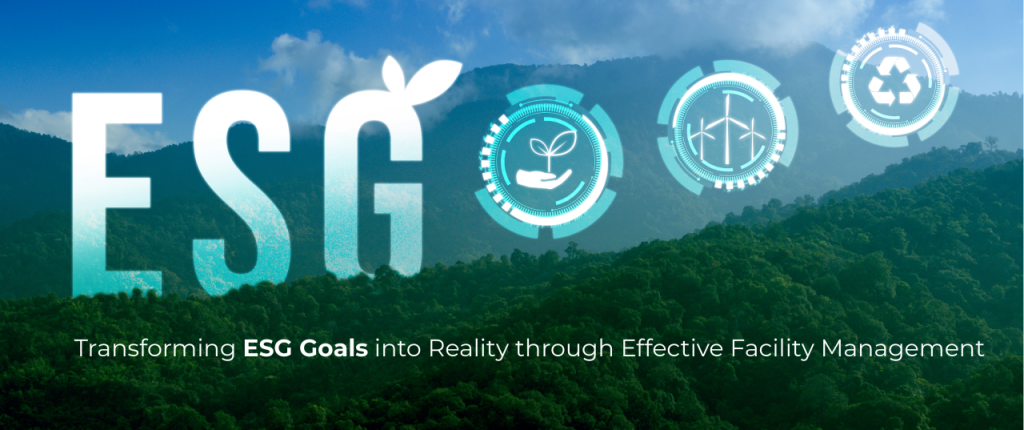In today’s rapidly evolving business landscape, sustainability and facilities management are no longer optional—they are essential. A key driver of this shift is ESG, which stands for Environmental, Social, and Governance. As organizations globally strive to become more responsible and sustainable, ESG has become a central focus, especially within the facility management sector.
So, what exactly is ESG, and how does it relate to facility management?
Understanding ESG: Environmental, Social, and Governance
ESG refers to three key factors used to measure the ethical and sustainability impact of a company’s operations:
- Environmental – How the organization impacts the planet (e.g., energy use, waste management, emissions).
- Social – How it treats people (e.g., labor practices, health and safety, community engagement).
- Governance – How it is governed (e.g., transparency, ethics, compliance, leadership structures).

For facility management (FM) professionals, ESG is increasingly influencing the way they manage buildings, resources, and operations. As companies work to align with ESG goals, facilities management is becoming a powerful lever for change.
Why ESG Matters in Facility Management
Facility managers are uniquely positioned to contribute to ESG initiatives by promoting sustainable building practices, improving energy efficiency, and creating healthier and safer work environments.
Here’s how ESG impacts the facilities management sector:
1. ESG Drives Sustainable Operations
Clients and stakeholders are placing more value on sustainability than ever before. FM firms are under pressure to adopt green practices, reduce emissions, and minimize resource consumption. Organizations that demonstrate a commitment to sustainability in facilities management are more likely to attract new business and retain existing clients.
2. ESG Enhances Financial Performance
Neglecting ESG risks can lead to higher operating costs, reputational damage, and loss of investor trust. On the other hand, companies that embed ESG into their facilities management strategy often enjoy:
- Lower utility and maintenance costs
- Better access to financing or government incentives
- A stronger brand reputation
3. FM is Central to ESG Implementation
From managing energy use and indoor air quality to optimizing waste disposal and employee safety, facility managers are at the heart of many ESG initiatives. Through sustainable facilities management, FM professionals play a direct role in reducing the carbon footprint of buildings and promoting ethical practices.

Five Techniques to Integrate ESG into Facility Management
Drawing insights from Factech’s article on integrating ESG in facility management, here are five effective techniques:
1. Energy Conservation and Efficiency
Implementing energy-efficient systems, such as LED lighting and smart HVAC controls, can significantly reduce energy consumption. Regular energy audits help identify areas for improvement, ensuring facilities operate sustainably.
2. Technological Integration
Leveraging advanced technologies, like Building Management Systems (BMS) and Internet of Things (IoT) devices, allows for real-time monitoring and optimization of facility operations. These tools facilitate data-driven decisions that align with ESG goals.
3. Adoption of Renewable Energy Sources
Incorporating renewable energy solutions, such as solar panels or wind turbines, reduces reliance on non-renewable sources and minimizes carbon emissions. This transition supports environmental objectives and can lead to long-term cost savings.
4. Promoting a Healthy Workspace
Prioritizing employee well-being through ergonomic designs, indoor air quality improvements, and wellness programs addresses the social component of ESG. A healthy work environment enhances productivity and employee satisfaction.
5. Compliance and Governance Management
Establishing robust compliance frameworks ensures adherence to legal and ethical standards. Transparent reporting and accountability mechanisms reinforce good governance practices within facility management.
How to Integrate ESG into Facility Management: The 7-Step Framework
The International Facility Management Association (IFMA) has identified a 7-step roadmap to help FM professionals successfully implement ESG into their operations:
- Raise awareness about ESG and its importance to your organization and industry.
- Understand your organization’s ESG goals and align your FM strategies accordingly.
- Evaluate the tools, technologies, and personnel needed to support ESG integration.
- Develop an ESG strategy that connects with your facility and real estate management plans.
- Ensure access to accurate data and encourage transparency across teams.
- Implement your ESG strategy at scale, using smart technologies, training, and operational changes.
- Continuously monitor and evaluate ESG performance to stay aligned with your goals.
Sustainability and Facilities Management: A Powerful Combination
As ESG continues to shape industries worldwide, sustainability and facilities management must go hand in hand. By embedding ESG principles into daily operations, facility managers not only reduce environmental impact but also contribute to employee wellbeing, community support, and corporate governance. This alignment builds long-term value and resilience for organizations.
The Role of Technology: Facility Bot and ESG Excellence
To successfully execute ESG strategies, facility managers need the right digital tools. Facility Bot is a leading facilities management software in Singapore that helps streamline operations, track sustainability metrics, and support data-driven decision-making. From maintenance automation to energy usage tracking, Facility Bot empowers FM teams to meet ESG goals more efficiently and effectively.
Whether you’re just beginning your ESG journey or looking to improve your existing practices, Facility Bot provides the tools and insights needed to make sustainability in facilities management achievable and impactful.




